This Dominican Tostones recipe (patacones) is what dreams are made of. These crispy twice-fried green plantains are served with an easy homemade cilantro garlic sauce and a delicious garlicky pink sauce that is so addicting, you’ll want to make tostones on a regular basis!
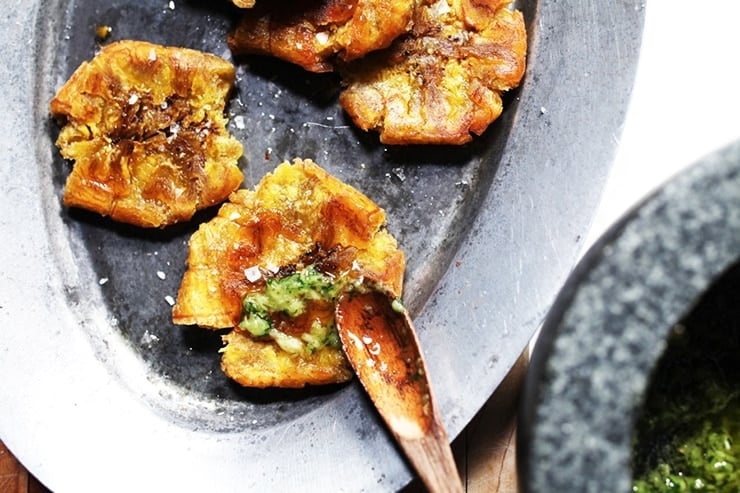
This crispy tostones recipe (twice-fried green plantains) transports me back to childhood summers spent in the Dominican Republic with my family at my Tia Kika’s home. She is my late grandfather’s sister and one of the last siblings left from his generation.
It has been nearly a decade since I have been back to her home. I can still remember the humidity on my skin, the old metal porch swing, ice-cold raspberry sodas served in tin cups, and crispy fried tostones sprinkled with sea salt.
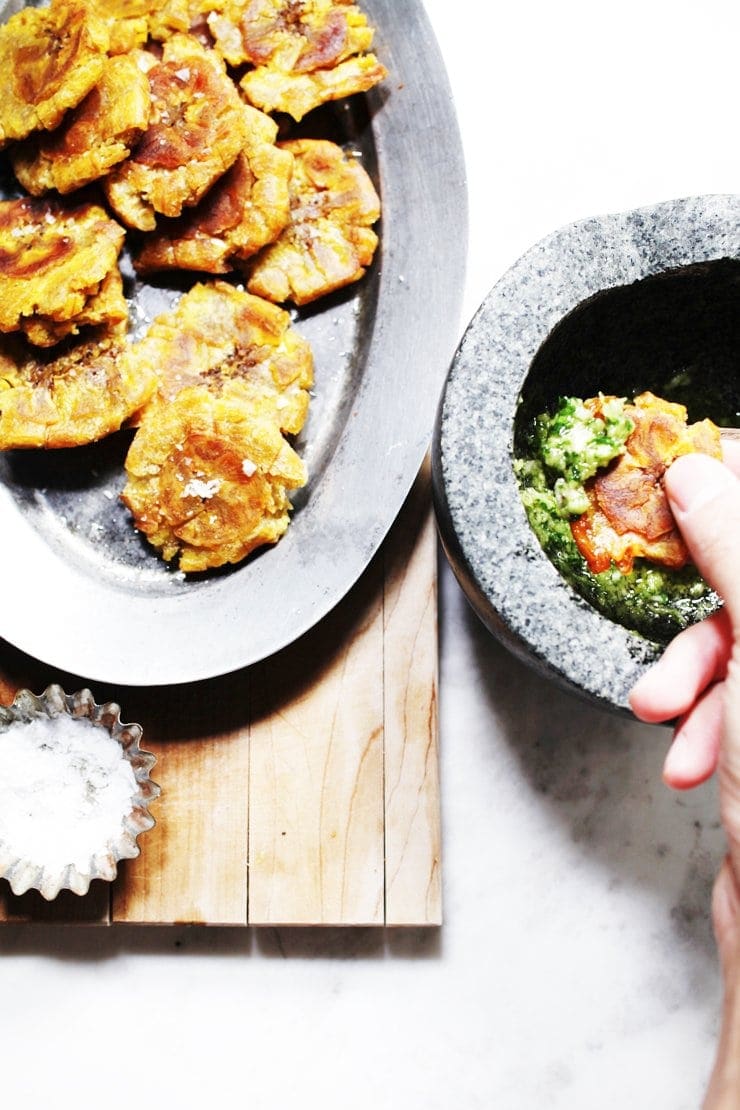
Spending the day at her house always meant we would be exposed to some of the best Dominican cooking that would leave a lasting impression on my life (tostones being one of them!).
Three generations of women would come together in her large kitchen to prepare lunch and dinner for the small crowd. Tia Kika and my grandmother would carefully orchestrate the meals together. Sure enough, each meal always consisted of a rice dish and plantains (my favorite being twice-fried green plantains, tostones).
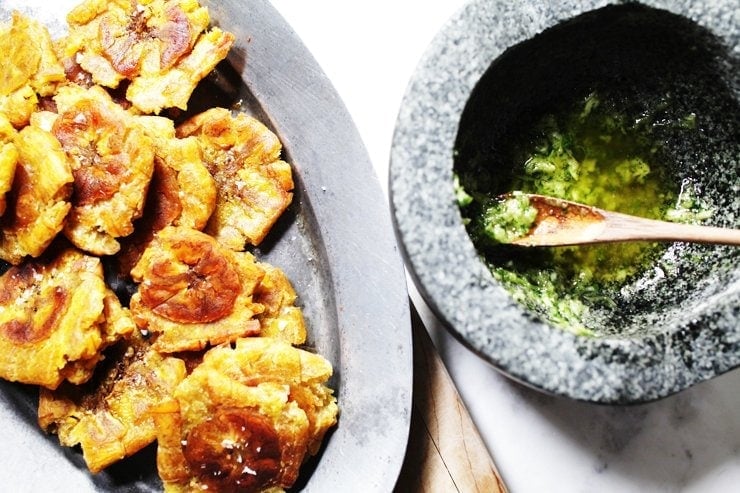
A metal folding table with chairs from the turn of the century was set up beneath the fruit trees that lead to the steps of Tia Kika’s home. That table meant an intense game of dominoes was about to happen between my grandfather, my Tio Umberto, Tio Ramón, and occasionally my Tia Milagros. The dominoes chips would clack against the metal table as the men would shuffle them and yell at each other. I would watch and listen to everyone’s strategies and the stories they told around that old metal table. Occasionally I would make my way into the house and ask my mother if we’d be having crispy tostones– I was obsessed to say the least.
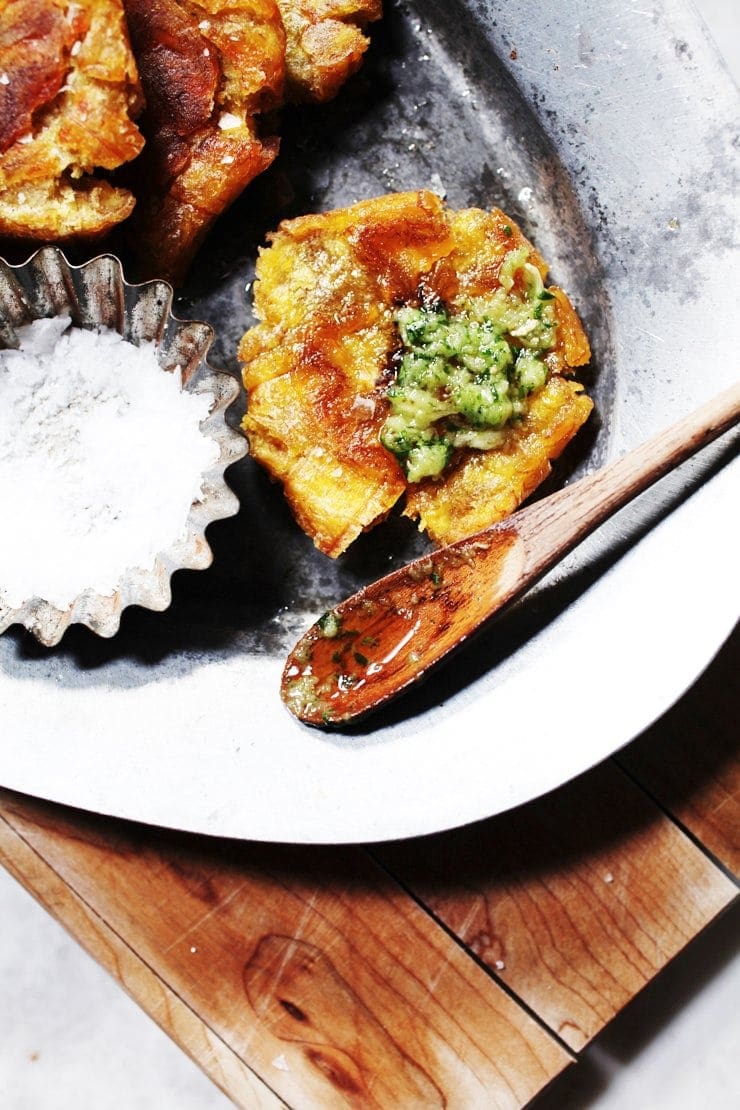
Dominicans consume plantains regularly- the main ingredient for tostones– they are an essential food found throughout Dominican cuisine and a lot of Latin American and Caribbean cuisines.
Tostones (also known as patacones) are just one of the many ways that Dominicans cook and eat plantains. For example, they are often found as crispy chips, as a mash, in stews, fried when their skins are a deep black to make sweet maduros (fried sugary sweet plantains), or they are double-fried to make deliciously crisp tostones. Plantains are used as the heart of many dishes; the way in which they are prepared and cooked is what makes them so authentically delicious.
Tostones require little effort to make. Green plantains are the basis for this dish, and they need to be prepared properly. The green plantains are peeled, cut, and soaked in salted water (sometimes with a couple cloves of smashed garlic), dried off, fried, smashed, and fried again until crisp on the outside and slightly soft in the middle.
Tostones are simple, but can be made to be so utterly flavorful and act as a good accompaniment to any meal or as a delicious afternoon snack.
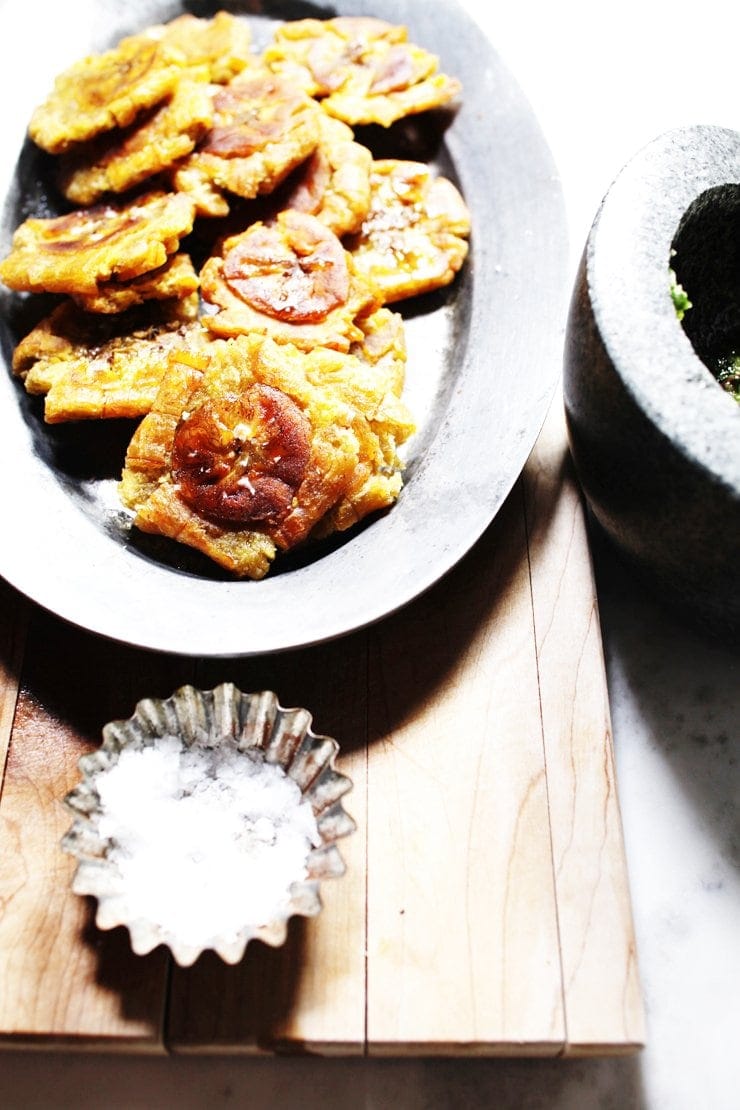
What are Tostones (Patacones)?
Tostones are twice-fried plantains. They are also known as patacones in some Latin American countries in South America. For Americans and some Europeans, potato chips (crisps) or french fries are a staple; for Dominicans and other Latin Americans, tostones are a comparable staple.
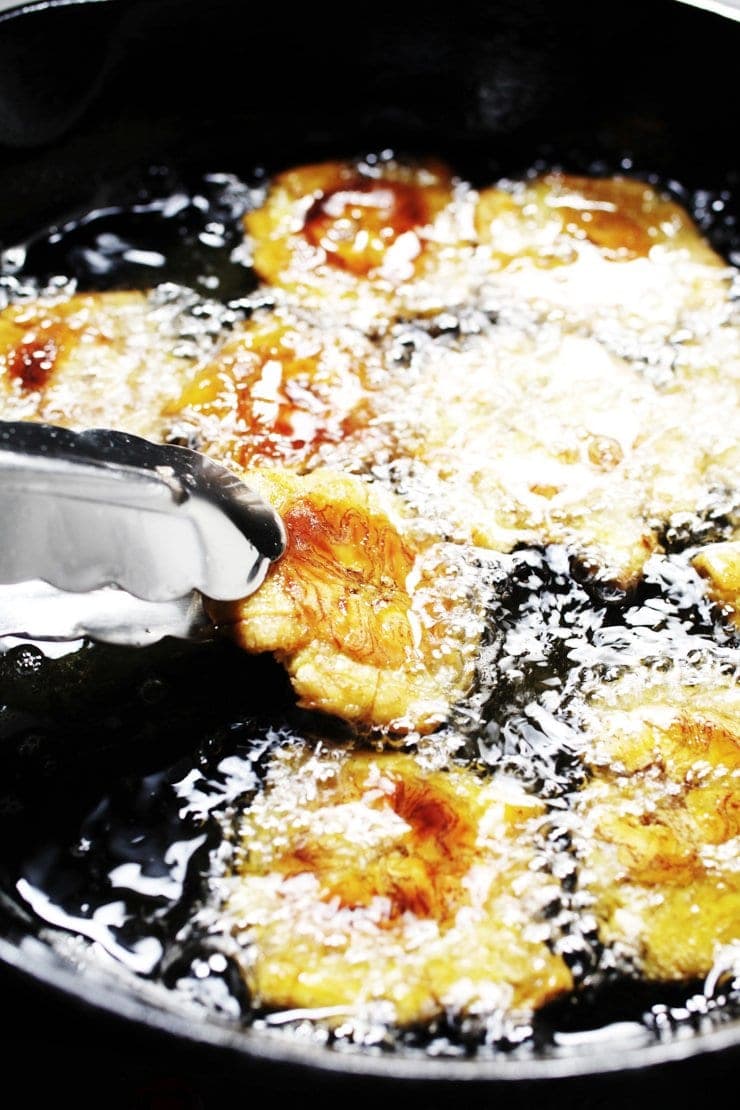
Tostones Recipe Ingredients
This authentic Dominican Tostones recipe consists of two parts: the crispy tostones themselves, and the dipping sauces.
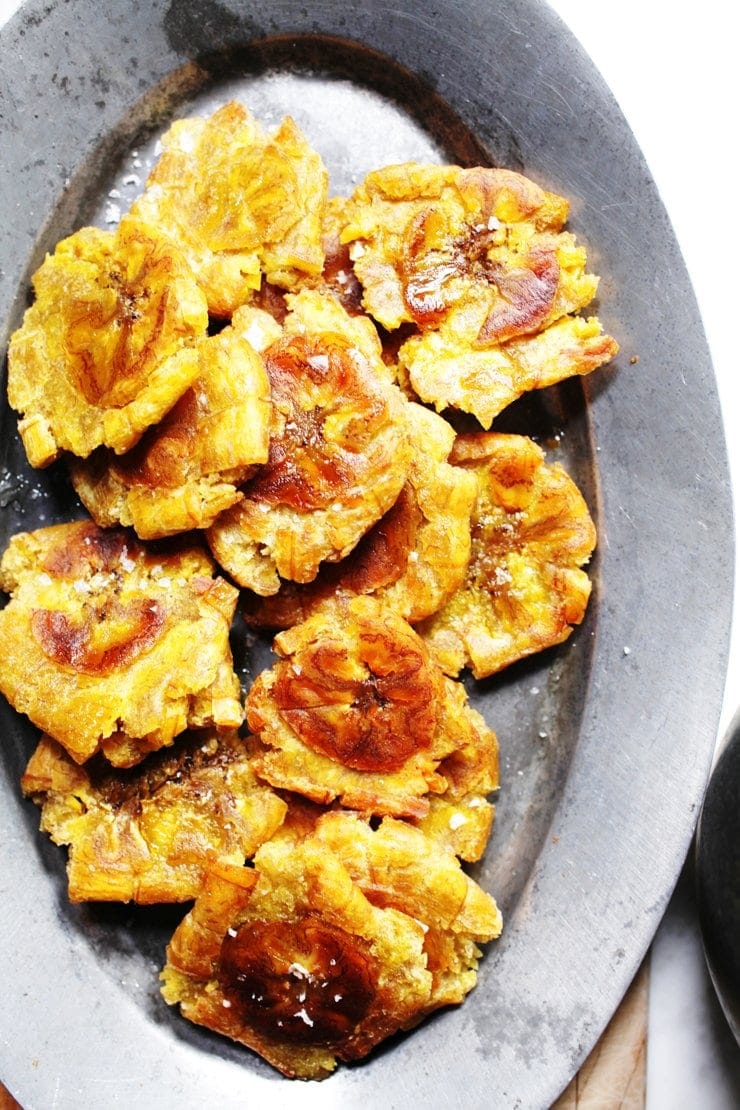
Ingredients to Make Tostones
• Green Plantains: Not to be mistaken for bananas, plantains are also found in the produce section of most major grocery stores and health foods stores. For this recipe, you want green plantains. The larger the better, because that means you are getting more bang for your buck as plantains are usually sold individually, rather than by weight.
• Salt: I use fine-grain sea salt to flavor the water the plantains will soak in before they are fried. I also like to use crunchy Maldon Sea Salt to top the tostones with to add some nice texture; it is entirely optional, though. Kosher salt works well here too. Honestly, use whatever salt you have on hand; keep in mind that the water should be as salty as the sea, and you should season your cooked tostones to taste.
• Water: Cold water will do. This is use to soak the cut plantains.
• Oil for Frying: I use sunflower oil. However, any neutral-tasting oil like canola, corn, grapeseed, peanut, or safflower oil will work. Feel free to use an olive oil blend– you don’t want to use extra virgin as using it for frying will ruin the integrity of the oil.
Dipping Sauces
• Mayo Ketchup (Salsa Rosada): this is a well-enjoyed dipping sauce for tostones. You simply need equal parts of mayonnaise and ketchup and a clove of finely grated garlic (or more, if you like it garlicky).
I like to use a garlic crusher, but feel free to use a microplane grater, simply make the garlic into a paste with a knife, or use a mortar and pestle.
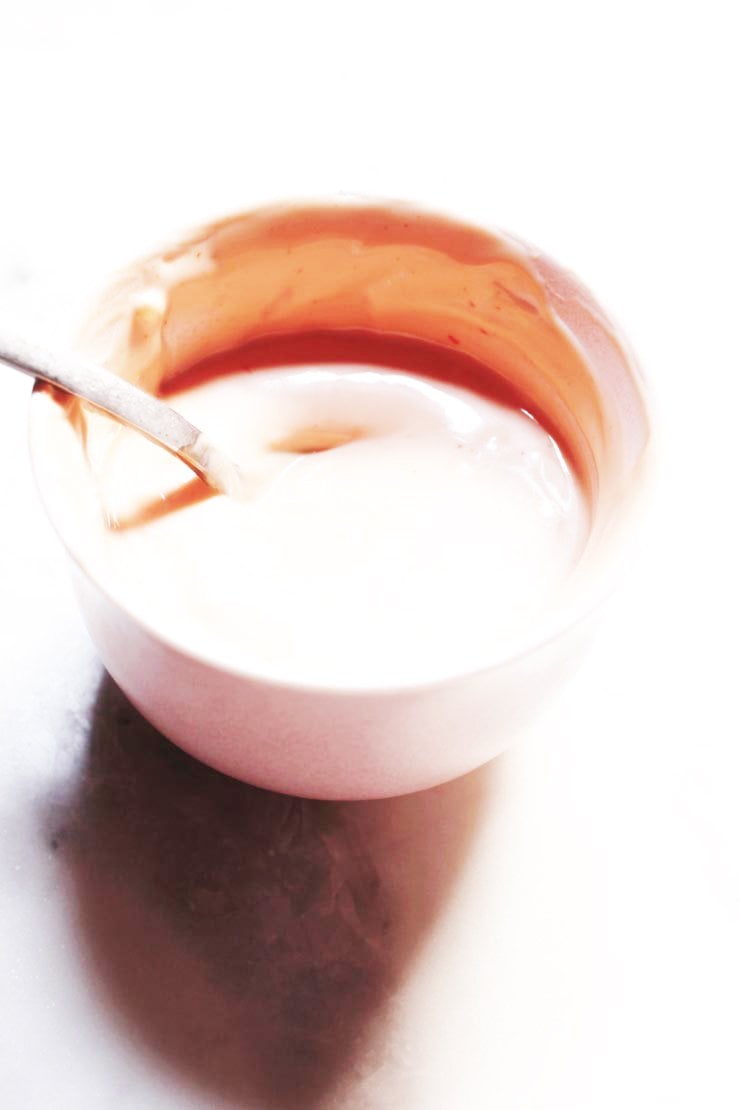
• Ajillo: if you enjoy garlic, you will enjoy dipping your crispy tostones in ajillo, a garlic and oil sauce. It is very simple to make and requires garlic, salt, and olive oil.
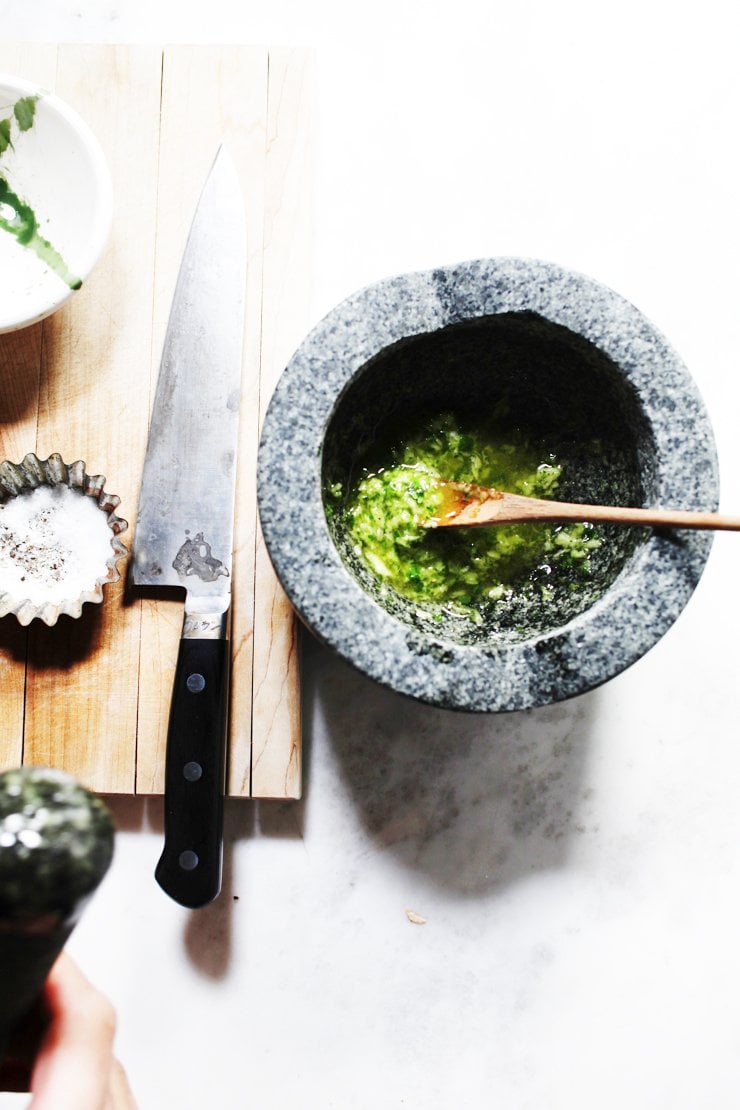
• Cilantro (Coriander) Ajillo– this is for those who love cilantro. I like to add a bit of cilantro to my base ajillo recipe, it adds brightness and freshness to this garlic sauce and compliments the tostones perfectly.
Authentic Dominican Tostones Recipe: Special Equipment
• Tostonera (a plantain press; optional)– most Dominicans, including myself, own a small wooden or metal device, a tostonera, that is used for flattening the plantains after their first fry. The wooden tool not only is helpful when making tostones, it often doubles as wall art when not in use.
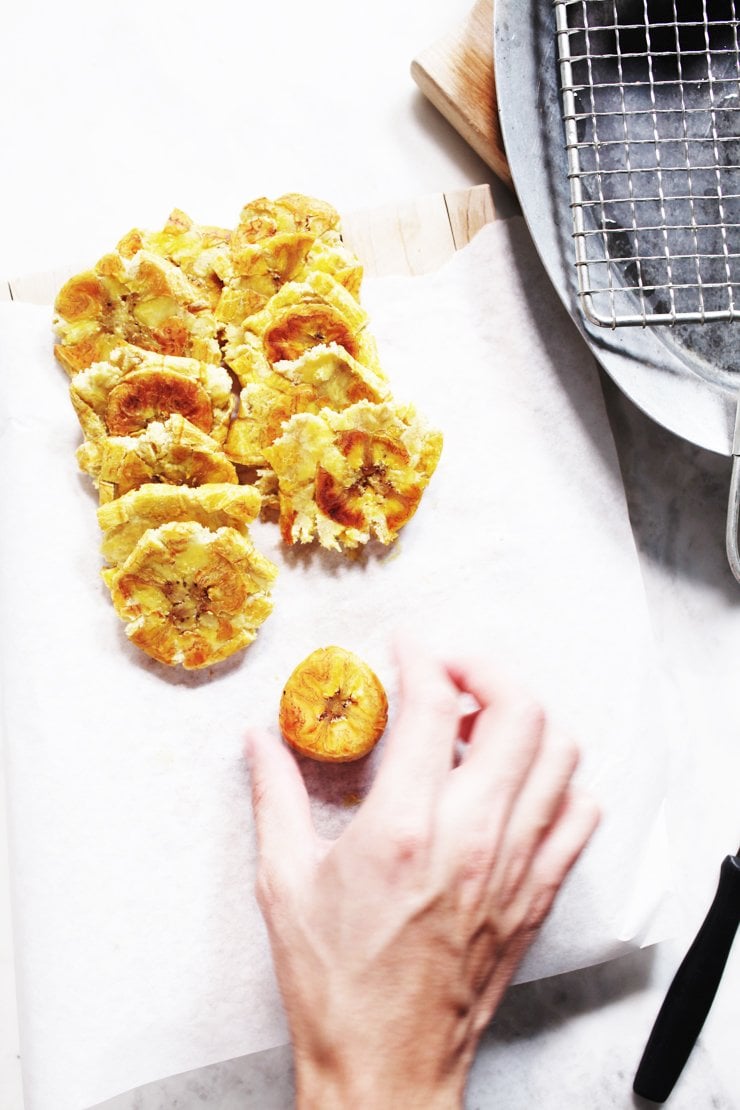
Don’t get caught up on finding a tostonera, the flat bottom of a sturdy coffee mug, a sturdy plate, the bottom of a glass, or the smooth side of a meat mallet works great too.
How to Pick and Peel Green Plantains
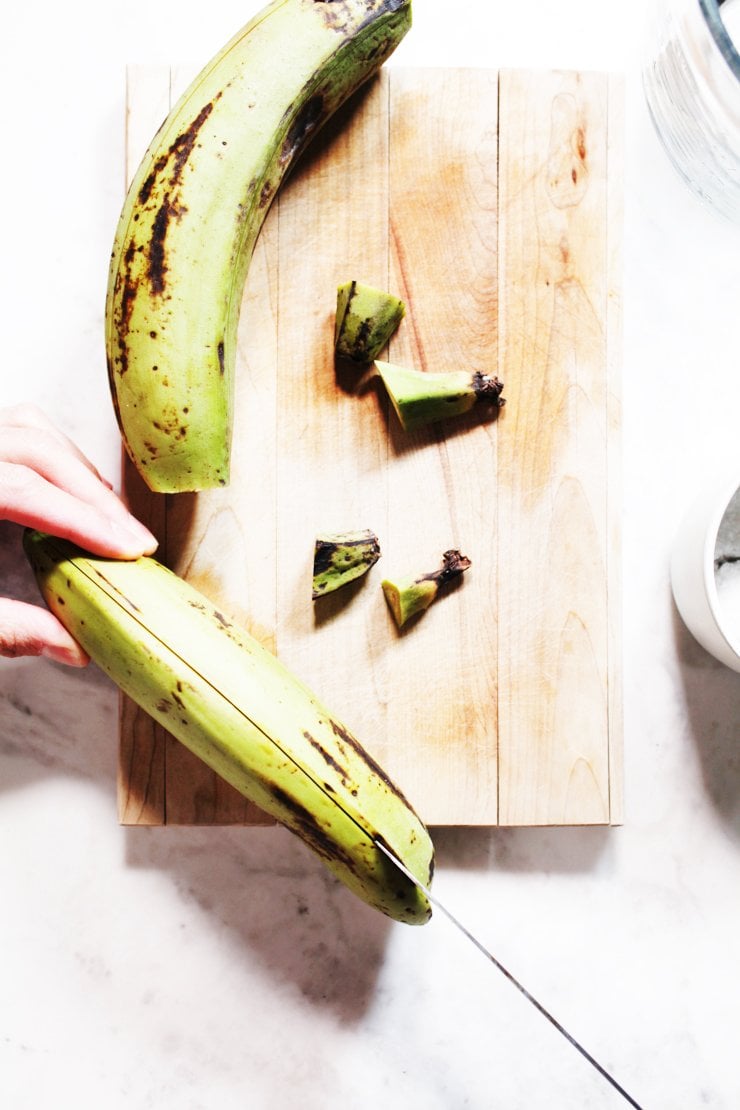
How to Pick Plantains
Plantains should not be confused with bananas. The best kind of plantains for tostones (twice-fried green plantains) are beautifully green plantains that are firm and do not have any yellow on their skins. Yellow and brown skin means the plantain has already started to sweeten and soften– you don’t want that for this particular recipe.
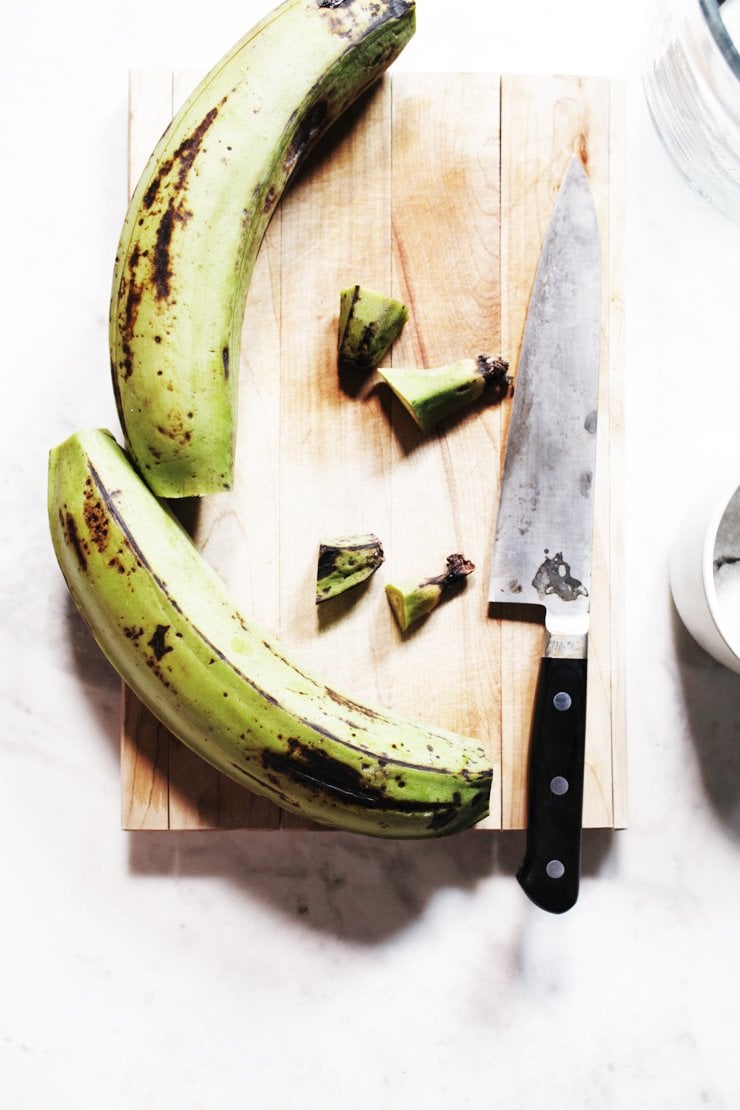
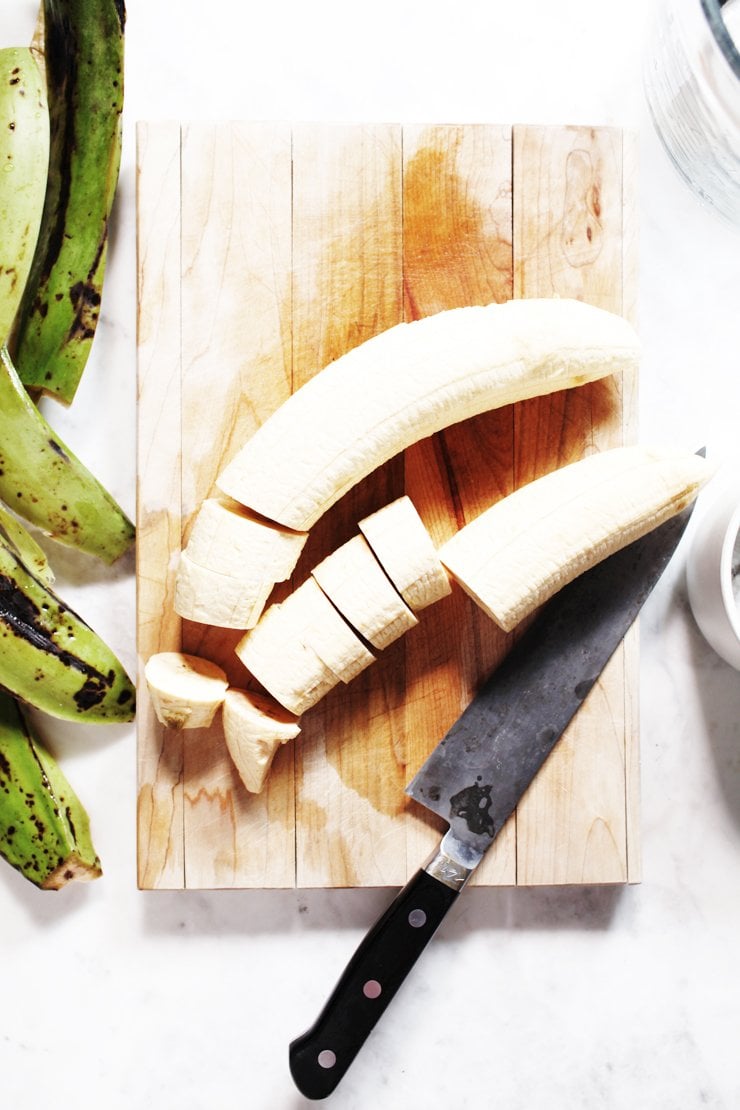
How To Peel Plantains
The easiest way to properly peel a green plantain is under running cold water.
- Start by cutting off each end of the plantain.
- Make 3 to 4 vertical cuts along the skin of the plantain.
- With your thumb, pry the skin away from the flesh of the plantain, under the running water. Alternatively, you can use a dull knife or butter knife to push the skin away from the flesh of the fruit.
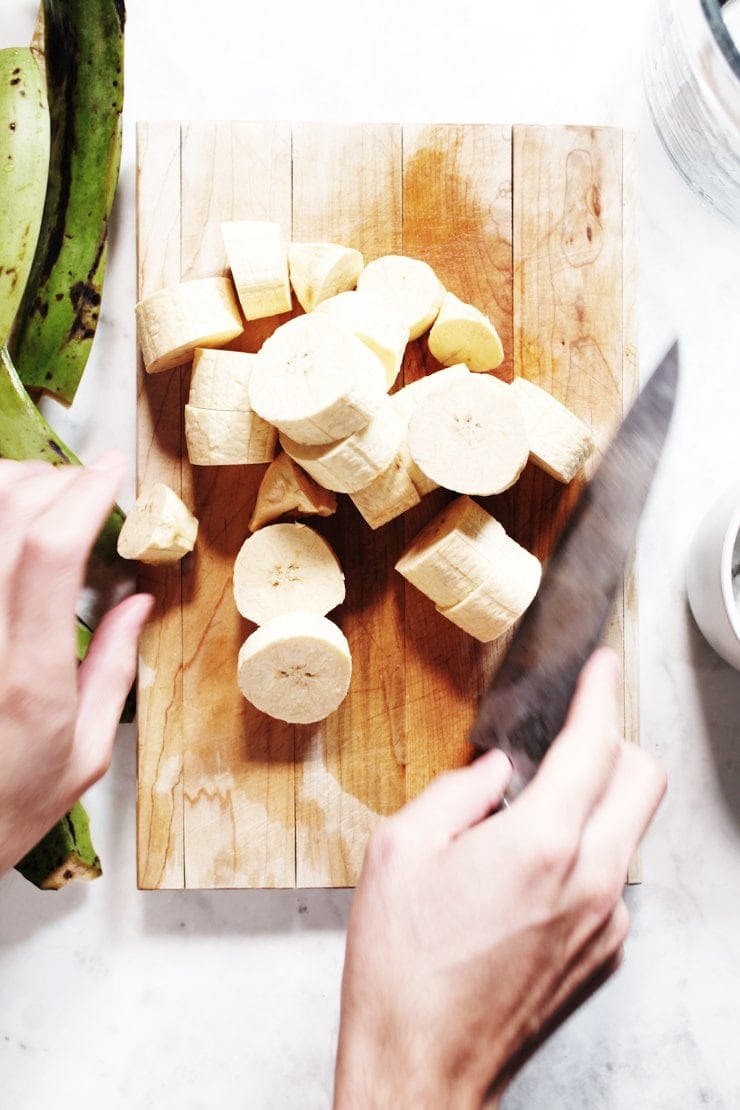
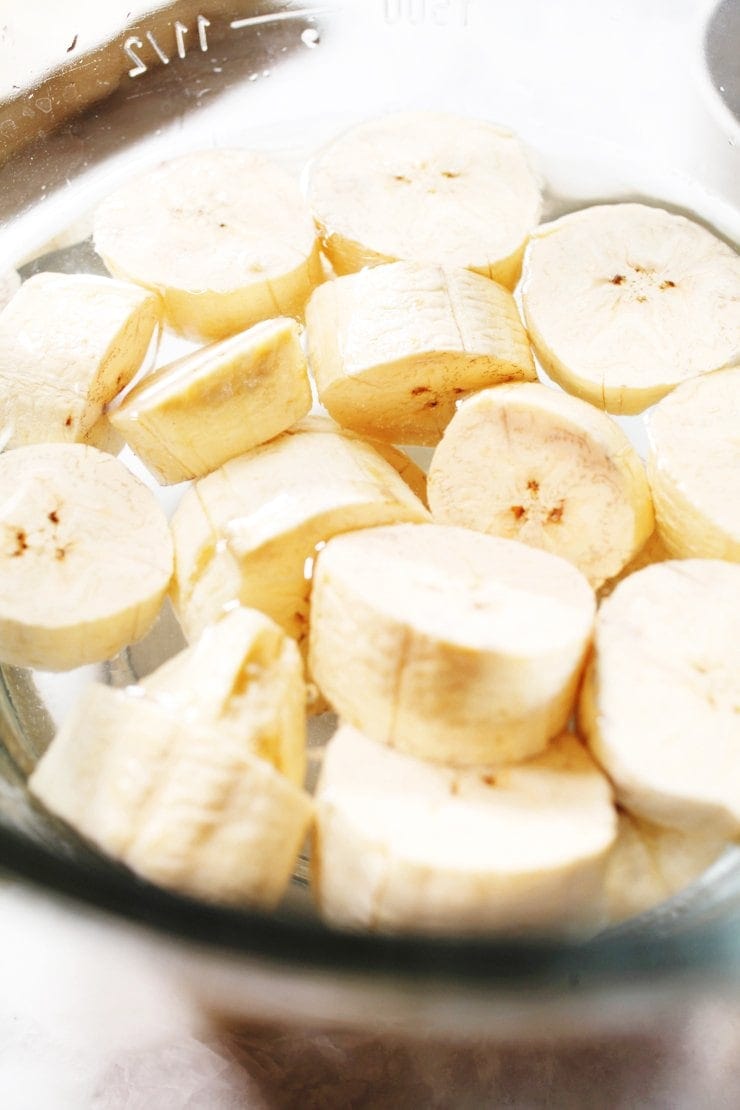
How to Make Dominican Tostones
Tostones are made using underripe green plantains that have been cut into roughly 1-inch pieces. They are traditionally fried. They’re cooked until soft and lightly golden brown.
Once fried, the plantains are flattened and returned to the oil to fry until they are tanned and crisp (as mentioned before, they are twice-fried green plantains). The tostones are topped with salt and served with delicious dipping sauces like an ajillo or salsa rosada.
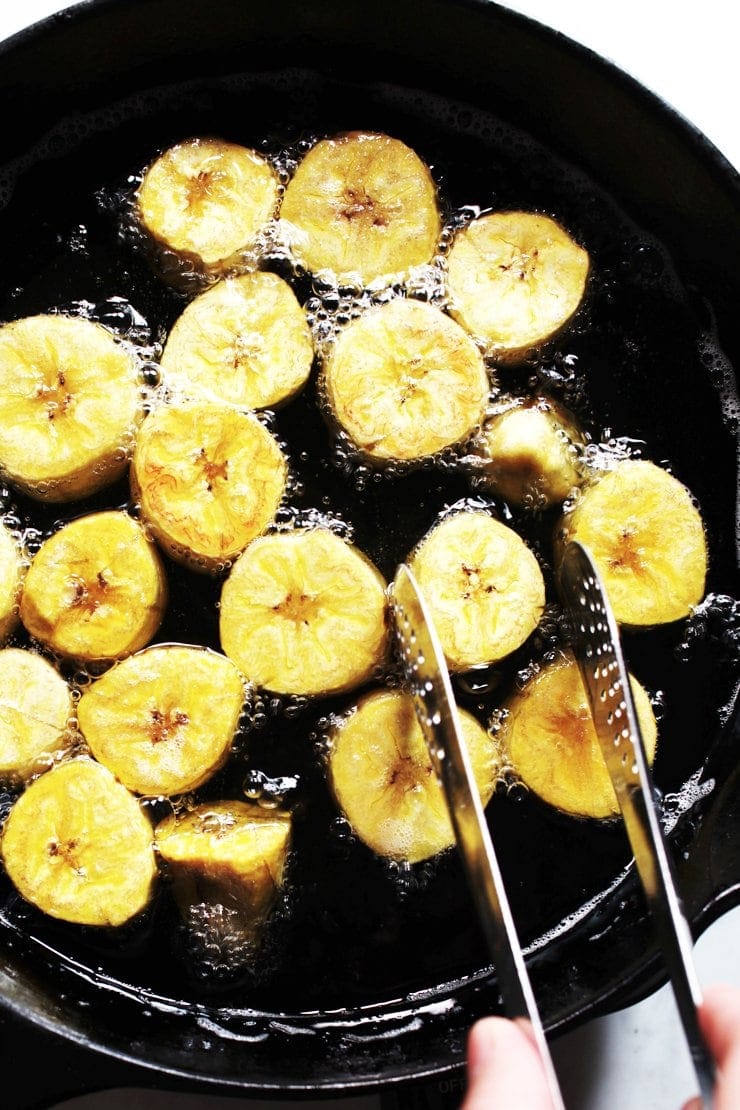
How to Serve Tostones
Many Dominicans and Puerto Ricans will agree that a mayo ketchup (also known as salsa rosada) is a delicious sauce for dipping these delightful crispy tostones.
Another accompaniment is a quick homemade garlic oil dip called ajillo, which consists of crushed garlic, a bit of salt, and olive oil (which is sometimes warmed). I like to add cilantro to my ajillo to keep everything fresh and delicious, but feel free to leave it out.
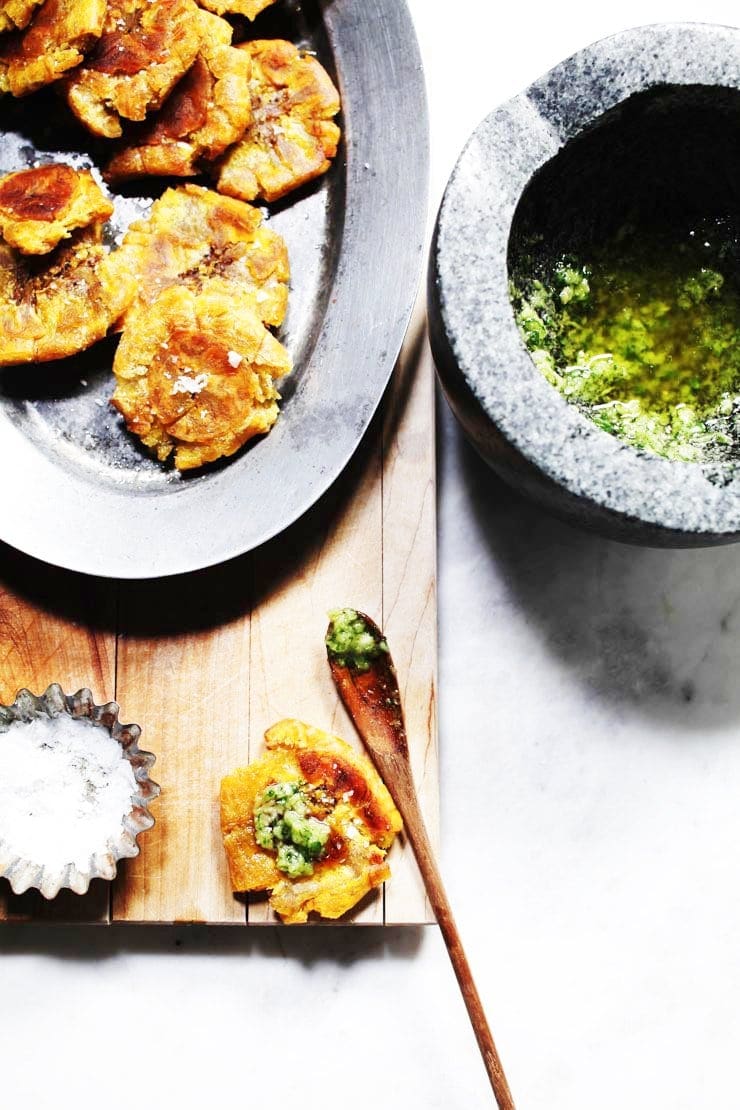
Can tostones be made ahead of time?
It’s quite easy to make tostones ahead of time. Going through the complete cooking process for these twice-fried plantains is not recommended, however.
- Fry ahead and freeze: The best way to make these ahead is by frying the unripe plantains once, flattening them, and letting them cool completely on a parchment-lined cookie sheet in a single layer to freeze later on.
- Transfer to freezer-safe bags: Once frozen in a single layer, place the cooked smashed plantains in resealable freezer bags to fry on a whim (they do not need to be defrosted).
- Refrigerate them for later: If you are looking to making the tostones within 24 hours of doing the first fry, you can also refrigerate them. Once fried, cool the tostones down in a single layer on a parchment-lined cookie sheet or plates, cover them, and place in the refrigerator for later frying.
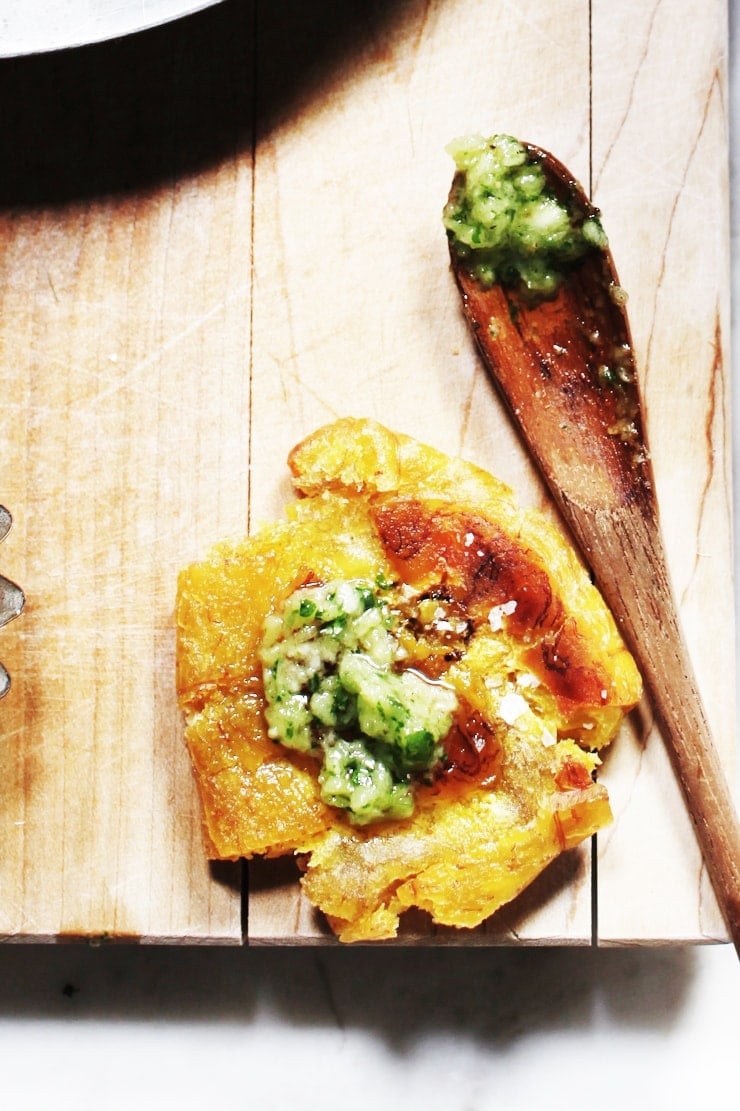
Other Delicious Recipes You Will Enjoy
Tostones Recipe
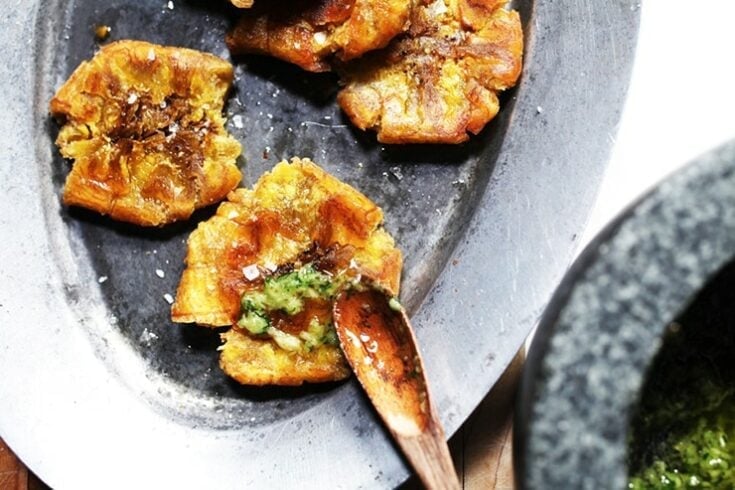
This authentic Dominican Tostones Recipe requires about 1 cup (250ml) or more of oil– enough to submerge the plantains to do a shallow fry. I use Sunflower oil, but any neutral-tasting oil will work (canola, corn, vegetable, peanut, etc.). Alternatively, a light olive oil blend that is made for frying would also work too.
You will need unripe green plantains for tostones; yellow ones will not do here as they have already started to soften and ripen. Bananas will not work for tostones, either. Plantains can be found at most grocery stores and health foods stores. For the soak, I often just soak the cut plantains in salted water; feel free to toss in a couple cloves of crushed garlic for a little more flavor.
Tostones are traditionally served with an ajillo, an easy homemade garlic dip. I've added some fresh cilantro (coriander) to mine to add some freshness. As simple as my ajillo with cilantro is, it does pack a lot of garlickly flavor. If that's not your thing, feel free to go light on the garlic. Another alternative dip, which I've added to the notes of this recipe would be a mayonnaise and ketchup combination– salsa rosada (pink sauce)– I usually add a clove of freshly grated garlic to this to add some more flavor.
Ingredients
Tostones
- 2 green plantains (not bananas)
- 1 tablespoon / 15 g fine grain sea salt
- 3 cups / 720 ml water
- About 1 cup / 240 ml sunflower oil or any neutral tasting oil (vegetable, canola, corn, etc.) for frying
Ajillo with Cilantro
- 4 cloves garlic
- 1/2 teaspoon / 3 g fine-grain sea salt
- 1/4 cup / 8 g fresh cilantro (coriander), lightly packed
- 1/4 cup / 60 ml olive oil
Salsa Rosada (Mayo Ketchup)
- 1/2 cup / 150 g mayonnaise
- 1/2 cup / 150 g Ketchup
- 1 clove garlic, finely grated (garlic paste would work too)
- fine-grain sea salt, to taste
Instructions
- Slice the ends off of the plantains. Make three vertical cuts along the length of the plantain, only making sure that you are cutting into the skin. Under cold running water, using your fingers or a butter knife (the tip of your knife works best) to remove the skins. With a sharp knife, cut each plantain into ¾-inch to 1-inch slices. Set aside.
- Mix the 3 cups of water and salt together (just until the salt is dissolved). Place the thick rounds in the salt water for ½ hour or no less than 10 minutes.
- In the meantime, prepare the Ajillo: Using a mortar and pestle, pound the salt and garlic together. Add in the cilantro and break it down until it's pasty. Once that's done, mix in the olive oil and adjust the salt to taste. Alternatively, you can use a food processor or finely chop the cilantro, grate the garlic, and mix everything together.
- To make the Mayo Ketchup Sauce: In a small bowl, combine ketchup, mayonaisse, and garlic, and set aside (this will be good for up to 3 days, covered, in the refrigerator).
- Remove the plantain slices from the water and dry them well with paper towel or a kitchen towel. This will prevent oil splatters.
- Heat the oil on medium heat (oil should be around 325ºF / 160ºC). In batches, place the plantains in the hot oil and cook for about 4 minutes on each side until golden brown. Repeat with all the plantains, then remove from the oil and drain.
- Place one of the fried plantains between two pieces of parchment paper. Using the flat side of a meat mallet, the bottom of a mug, bottom of a glass, or bottom of a heavy sauce pan or small cast-iron skillet, smash the plantain down until it is evenly flattened (roughly 1/4-inch / 2/3-cm thick. Repeat with the rest of the fried plantains.
- While smashing all of the plantains, crank the heat to medium-high heat (the oil should register 350ºF / 180ºC to 360ºF / 190ºC). After all of the plantains have been smashed, fry them once again until golden brown and crispy. Immediately salt them as they come out of the oil.
- Serve Tostones with Ajillo and or Mayo Ketchup Sauce.
Notes
Feel free to experiment with your flavors for this delicious side dish! Top the tostones with a bit of lime juice or with a little queso fresco, as well, to make for a delicious appetizer!
Nutrition Information:
Yield:
18 TostonesServing Size:
1 TostoneAmount Per Serving: Calories: 58Total Fat: 3gSaturated Fat: 0gTrans Fat: 0gUnsaturated Fat: 3gCholesterol: 0mgSodium: 355mgCarbohydrates: 8gFiber: 1gSugar: 4gProtein: 0g
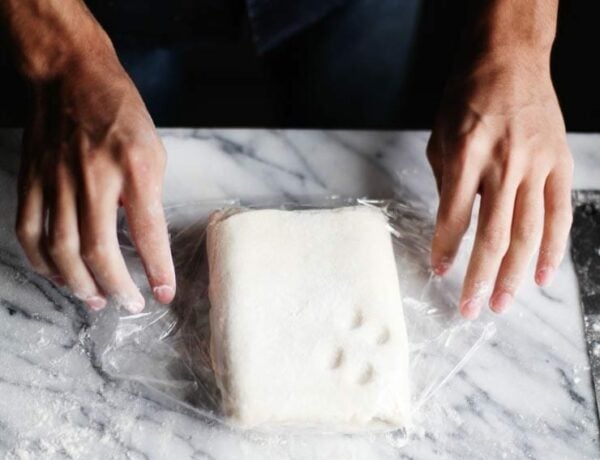
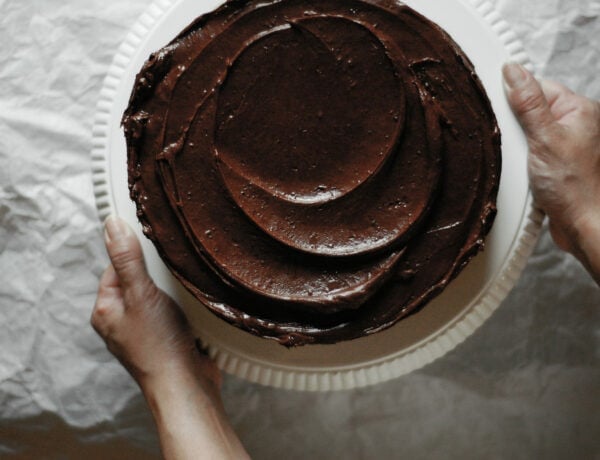

13 Comments
Marta Nunes
July 19, 2020 at 4:32 amI found your recipe on instagram. As a fellow Dominican this makes my heart go pitter patter. I miss the DR so much right now and this beautiful post brings back great memories for me. The sauces you included look incredible especially the coriander Ajillo. Thank you for sharing!!
Gary Hernandez
July 19, 2020 at 11:28 amCuban here. Just made these last week. You shouldn’t need this much oil. About quarter cup will do. Just cover the pan on the first fry and they’ll cook through enough to squish. On the second fry you only need to submerge half the flattened tostone to fry it properly. Then flip. Also, a one inch cut gives you some really small tostones. I‘d suggest at least 2 inches. Lastly, don’t put ketchup anywhere near these. I’m looking at my Puerto Rican friends and they’re in complete agreement. A little salt. Maybe some garlic.
Kamran Siddiqi
July 19, 2020 at 3:52 pmHi Gary- Nowhere did I claim these to be a Cuban or Puerto Rican version; these are the same DOMINICAN Tostones I grew up on. The title of this post clearly labels this recipe as such. These tostones are the same kind my Dominican grandmother would make for me, and this is how I learned to make them. They come out perfectly crisp and delicious every time. If you prefer to use less oil, please do so. However, they will not achieve the same crisp and tasty results as the ones I’m sharing. While I do appreciate constructive thoughts on the matter of oil use, this isn’t the place to dismiss someone else’s food or experiences, or to claim superiority over Latin American cuisines simply because you think you are an authority on the matter. If you were, you wouldn’t be looking at a post on the subject. My Puerto Rican friends and family members (both Stateside and on the island) eat their tostones with mayo ketchup (salsa rosada) and garlic is always welcome. My Dominican friends and family feel the same. Further ignorant commentary from you or anyone else on this matter will make their way into my spam folder, where comments get lost amongst gibberish about Nike sneakers and fake Louis Vuitton handbags.
Miguel
May 10, 2022 at 9:05 pmYessssssssssss!!!!!!!!!! Lol. This was the greatest.
Oh, and great recipe post.
Maddy Perez
July 25, 2020 at 5:40 am@Gary: I’m from Puerto Rico and we have mayo ketchu everywhere. It’s a staple…. especially with tostones. Your friends must be imaginary jaja!
@KAM- thank you for representing Dominicans with these beautiful tostones and these delicious sauces. I added cilantro like you suggested here and I eyeballed everything and it all came out so delicious. My family loved it!!! Thank you XO – Maddy
Arielle
July 27, 2020 at 7:49 pmI have to agree with Maddy here. I was just in Puerto Rico visiting my 80 year old grandmother. When I was frying some of these bad boys up she came over and told me to make a salsita of mayochup with garlic. Not to mention every restaurant we went to whether we ordered tostones, mofongo, or even trifongo it was always accompanied with pink sauce. Honestly it’s like gliding the lily to a perfectly salted and crisp tostone.
Carmen Zapata
September 20, 2020 at 4:25 pmMade these this afternoon for a quick snack. I added some smashed garlic cloves to the water like you mentioned. Chefs’ kiss!! Thank you for the recipe!!
Denise
March 8, 2021 at 4:46 pmHi Friend! Made these last weekend and served with poached eggs and avocado – I know, not very traditional. And from the comments here I might get some hate. HA!
Didn’t have the ingredients to make the sauces you recommend but will next time! They came out perfect!!! WE loved them as they reminded us of a travel time to Costa Rica where we sat at a dive bar drinking cold beer and nibble on fried goodness with the locals.
Kenny L
April 10, 2021 at 3:30 pmMade these tostones for me and my Dominican girlfriend last night following your recipe. Everything including the sauces were so delicious. 5 stars!!!
Kamran Siddiqi
April 13, 2021 at 3:32 amKenny, so glad you and your girlfriend enjoyed these! Makes me so happy to hear that you enjoyed the accompanying sauces as well!
helan
August 23, 2021 at 4:19 amThanks For Sharing this Amazing Recipe. My Family Loved It. I will be sharing this Recipe with my Friends. Hope They will like it.
Hannah
February 2, 2024 at 9:49 pmWhy must I see a recipe like this when I’m eliminating oil. You’re killing me.
Silvana Gerlein
February 7, 2024 at 4:51 pmAs a Colombian (Barranquilla), I also own patacones my self. I’d say patacones / tostones are more of a caribbean food; however, I wouldn’t be surprised if I found them in Africa just as I found tajadas (fried ripe plantains)! I found Nigerians having tajadas and owning them!!!
Two tips to eat tostones with:
*Suero, which is similar to a sour cream. In the US, just add some salt and lemon to some sour cream and voila! Or you could just get some Mexican or Salvadorean cream which will also work wonders!
*Hogao. This is a guiso (fried sauce) made by frying on VERY LITTLE OIL and low heat (more like sauteé) a little minced garlic, chopped tomatoes, red onions, and green onions. Chop everything tiny. Add salt, pepper, and achiote spice to give it color. After it looks “dry”, just add some water to let everything cook until tender and saucy. It’s literally yummy for the tummy!!!
You can even put some hogao over fried patacones, some mozzarella and a little bit of chopped basil and put them in the oven on broil until the cheese melts and gets a bit golden.
Patacones are also amazing with guacamole, tuna antipasti, meat or chichen bites….. you name it! It’s just a matter of creativity!!!
Also, try patacones with the plantain when its not ripe but not green, its on its way to getting ripe… the sweet touch on the crunchy patacón topped with salt is out of this world.